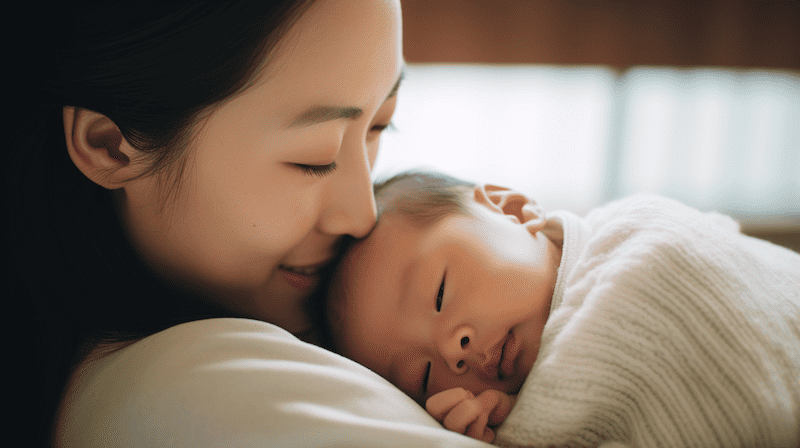So, you’ve got a tiny human in your arms, and the fear of mishandling them is real. But fear not because mastering the art of holding and handling a newborn is within your reach.
Whether you’re a first-time parent or just in need of a refresher, understanding the best practices for safely cradling your little one is essential. The right techniques not only promote a stronger bond between you and your baby but also contribute to their overall well-being.
Stick around to discover the essential tips and techniques for safely holding and handling your precious newborn, and gain the confidence to navigate this new chapter with ease.
Safe Holding Techniques
When holding a newborn, ensure their stomach is turned toward yours to maintain a safe and secure position, especially while sitting down. This position enables skin-to-skin contact, fostering a strong emotional connection and regulating the baby’s body temperature and breathing.
Supporting the baby’s head and neck muscles is crucial. Cradle their head with one hand while supporting their bottom with the other hand, ensuring their neck is well-supported. When lifting the baby, remember to place one hand behind the head and neck and the other under the bottom, protecting their delicate head and neck muscles, especially during the first few months.
The football hold and the “Cradle Hold are great techniques, providing a comfortable and secure hold for both you and the newborn. Mastering safe holding techniques not only ensures the baby’s physical safety but also enhances the bonding experience between you and the newborn.
Holding Your Baby Upright
Ensure that your baby’s back is well-supported and their stomach is facing towards you when holding them upright for comfort and security. Supporting your baby’s head and neck in the upright position is crucial for their safety and stability. This helps in developing critical neck muscle control.
By maintaining a supportive touch, you create a secure and calming environment for your baby. Keeping your baby upright after feeding aids digestion and prevents discomfort.
When passing your baby to someone else, ensure they also support the baby’s head and bottom before releasing your grip for safety. Remember to use proper lifting techniques, supporting the head, neck, and bottom to avoid injury.
Washing Hands Before Holding
Before holding the newborn, it’s important to thoroughly wash your hands with soap and water to prevent the spread of germs. This is crucial for the well-being of the delicate newborn. If soap and water aren’t immediately available, use an alcohol-based hand sanitiser.
Make sure to cleanse your fingers, palms, and under the nails to reduce the risk of infection. Encourage others to do the same before holding the baby to maintain a hygienic environment.
It’s also important to wash your hands regularly, especially after coughing, sneezing, or touching potentially contaminated surfaces. By prioritizing hand hygiene, you contribute to creating a safe and healthy environment for the newborn and demonstrate your commitment to their well-being.

Mind the baby’s soft spots
After washing your hands thoroughly, the next step is to be mindful of the baby’s soft spots when holding and handling them. When cradling the baby, ensure that their head is supported and your hand is behind their neck. Avoid putting pressure on the baby’s soft spots, which are the areas on the head where the skull bones haven’t fully fused. You can identify these spots as slightly sunken areas on the top and back of the baby’s head.
When holding the baby, make sure to support their head and neck, and be cautious around these soft spots. It’s also important to be mindful when bathing the baby, ensuring that no pressure is applied to these areas.

Unsafe Motions and Positions to Avoid
When holding a newborn, be mindful of avoiding shaking or jostling the baby to prevent serious brain injuries such as Shaken Baby Syndrome.
Always keep the baby in an upright position and ensure a secure hold with extra support, especially for their neck. Failing to do so can risk injuring the baby’s delicate neck and spine.
Additionally, never carry the baby with one hand, as it may result in inadequate support and potential mishaps.
Refrain from placing the baby in positions where they can easily roll or fall off, such as on high surfaces or unsecured areas.
Getting Better With Practice
To improve your skills in holding and handling a newborn, practice different holding positions to find what works best for both you and the baby. As you spend more time practising, you’ll gradually become better at holding and comforting your newborn. This not only builds your confidence but also creates a serene environment for the baby.
With consistent practice, you’ll develop a better understanding of the baby’s cues and preferences for holding positions. Additionally, getting better with practice extends to feeding, whether it’s through breast milk or bottle feeding. The more you practice, the more adept you’ll become at ensuring the baby’s comfort and well-being during feeding times, further strengthening the bond between you and your newborn.
Keep practising, and you’ll become more skilled and comfortable in handling and holding your newborn.
Holding a Newborn During Feeding
As you build your confidence and become more skilled in holding and comforting your newborn, it’s important to also understand how to hold them during feeding to ensure their comfort and well-being. Here are some essential tips for holding a newborn during feeding:
- Hold the baby in a semi-upright position while bottle-feeding to prevent choking.
- Use different breastfeeding positions for optimal latch and comfort.
- Support the baby’s head and neck for the first 6-8 weeks while breastfeeding.
- Move the baby over the shoulder to avoid stimulating them during feeding.
- Hold the baby facing away from the breast while breastfeeding to prevent fussiness.
Understanding these techniques will help you feed your baby safely and comfortably, promoting a peaceful and enjoyable feeding experience.
Holding a Newborn While Burping
If you’re looking to ensure your newborn’s comfort and well-being while burping, start by sitting them upright against your chest and gently patting their back. Ensure the baby’s head is supported and their body is angled slightly forward to avoid spitting up. Use one hand to support the baby’s chest and the other hand to pat or rub their back gently. Burping the baby after feeding is essential, and keeping them in an upright position for about 10-15 minutes helps prevent discomfort. The shoulder hold is a secure and comfortable position for burping, with the baby’s head resting on your shoulder as you gently sway or pat their back. This technique promotes effective burping while providing a soothing and secure environment for your newborn.
| Holding a Newborn While Burping | Tips for Comfortable Burping |
| Sit the baby upright against your chest. | Pat their back gently to help them burp comfortably. |
| Support the baby’s chest with one hand. | Gently pat or rub their back with the other hand. |
| Ensure the baby’s head is supported. | Angle their body slightly forward to avoid spitting up. |

Holding a Newborn During Bathing
To securely hold a newborn during bathing and ensure their safety and comfort, follow these steps:
- Cradle the baby’s head and neck securely, keeping their head above water level to prevent any risk of water entering their nose or mouth.
- Support the baby’s body with one arm while using the other hand to gently wash them, ensuring a stable hold throughout the process.
- After bathing, wrap the baby in a towel and continue to support their head and neck as you lift them from the bathing area.
- Always check the water temperature before bathing to ensure it’s lukewarm and safe for the baby.
- Remember that newborns lack strong neck muscles, so it’s crucial to use your free arm to provide additional support and stability.
Safety Tips for Holding Your Baby
After ensuring a secure hold during your newborn’s bath, it’s essential to always support their head and neck when holding them to prevent injury. Ensuring the safety of your baby is paramount, and here are some safety tips to keep in mind while holding your newborn:
| Safety Tips | Description |
| Support the head and neck | Always cradle your baby’s head and neck with one hand while supporting their bottom with the other. This helps protect their delicate developing spine. |
| Wash your hands | Before holding your baby, ensure that you wash your hands thoroughly to prevent the spread of germs. |
| Hold the baby upright after feeding | Keeping your baby upright for about 30 minutes after feeding can help aid digestion and reduce the risk of reflux. |
| Avoid holding when tired | It’s important to avoid holding your baby when you are tired to prevent any accidental injuries due to fatigue. |
The Science of Touch
Understanding the significance of touch is crucial for fostering a strong emotional bond and promoting the overall well-being of your newborn. The Science of Touch is a powerful tool in caring for your baby, and here’s why:
- Skin-to-skin contact aids in the baby’s digestive processes and helps regulate their temperature, breathing, and heartbeat.
- Secure hugs are a cornerstone of developmental science, promoting the baby’s overall well-being and fostering a serene environment.
- Physical touch is crucial for the baby’s development, as newborns are unable to support their heads or move purposefully, making proper holding techniques essential for their physical integrity.
- Utilizing a baby carrier provides hands-free comfort, allowing you to keep your baby close while engaging in other activities.
- Warm, gentle touch on your baby’s feet can have a soothing effect, promoting relaxation and comfort.
Understanding the science of touch is essential for your baby’s well-being and emotional development.

Swaddling and Holding a Baby
To safely swaddle and hold a newborn baby, it’s important to learn proper techniques and understand their benefits for the baby’s comfort and well-being.
When swaddling a baby, ensure their arms are snugly wrapped against their body, leaving their hips loose to prevent hip dysplasia. This recreates the secure feeling of being in the womb, soothing and calming the baby. Swaddling can also improve the baby’s sleep quality by preventing them from being startled awake by their own reflexes. Make sure the swaddle isn’t too tight to avoid restricting the baby’s breathing or causing overheating.
When holding the baby, opt for the football hold or keep the baby close to your bare chest, which helps regulate their body temperature and promotes bonding.
Always ensure the baby’s diaper is secure before swaddling and holding them.
Conclusion
Congratulations! You’ve mastered the art of handling and holding your newborn! Remember to mind the baby’s soft spots and always wash your hands before picking them up.
Avoid unsafe motions and positions, and always hold your baby upright with care. With these safety tips and techniques, you can create a serene and secure space for your little one, enhancing their overall well-being.
Keep calm and carry on with confidence, creating a cosy and comforting environment for your precious bundle of joy.








